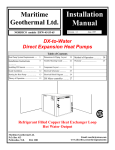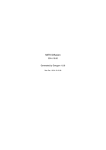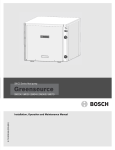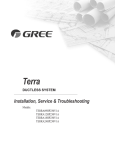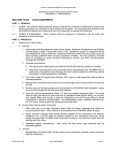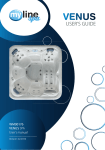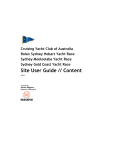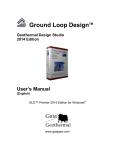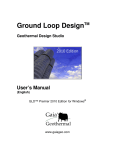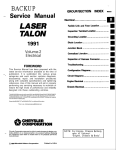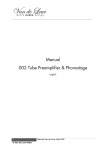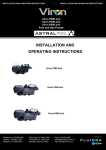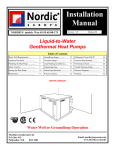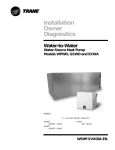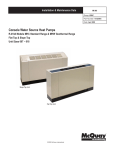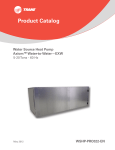Download Installation Manual
Transcript
Maritime Geothermal Ltd. Installation Manual NORDIC® models EM (DX) 45-55-65 Revision 1.5 17-Feb-00 Direct Expansion Energy Module Heat Pumps Table of Contents Heat Pump System Requirements ..... 3 Safety Controls ………... 14 Trouble Shooting Guide .......... 21 Conceptual Overview ……… 5 Starting the Heat Pump ……. 15 Performance Curves ……….. 24 Technology Explanation …….. 7 Component Layout ................ 17 Setting the Aquastat ……….. 27 Installing DX linesets .................. 11 Dimensions & Piping Layout 19 Electrical Schematic ..........………. 29 Inside Installation …………………. 12 EM Internal Schematic 20 Electric Block Diagram …... Domestic Hot Water ........................... 13 Min. Circuit Ampacity 20 Warranty ............................………. 31 30 Refrigerant Filled Copper Heat Exchanger Loop Hot Water Output Maritime Geothermal Ltd. P.O. Box 413 Petitcodiac, N.B. E0A 2H0 Email: [email protected] www.discribe.ca/nordic 17-Feb-00 Maritime Geothermal Ltd. A NORDIC® Direct Expansion Heat Pump System Energy Input: Solar Geothermal Storage System: Earth’s Mass HEATING Extraction & Rejection System: “EM” heat pump COOLING Heat Distribution: Infloor Heating Fan Coil Distribution Infloor Heating Fan Coil Ducted Systems NORDIC® DX Energy Module Page .... 2 Maritime Geothermal Ltd. 17-Feb-00 NORDIC® EM (DX) System Prerequisites 1. 2. 3. 4. There are four specific parts or sub-systems to a EMDX heat pump installation: The source of energy ............................................................... Solar & Geothermal The storage media ................................................................... The Earth’s mass Converting the energy to a useable form ................................... Heat Pump Distributing the heat ..................................................................Hot Water / radiant slab – fan coils Horizontal Loop Fields The successful application of a EMDX heat pump depends on sizing the machine correctly for the home or area to condition and providing enough land area or volume of earth from which to extract or reject heat. EMDX heat pumps react with the earth much like a conventional reversing heat pump and closed loop plastic earth heat exchanger. Heat that is available to the unit must travel through the earth and therefore the conduction capability of the earth in the location of the heat exchanger is very important. A unit used primarily for heating will have no problem with conduction and heat transfer since it will be cooling the loop during heating mode. Cooling the soil draws moisture towards the coils since they are colder than the surrounding ground. Horizontal loop fields should be laid out so that the copper coils have good cross-sectional influence on the minimum areas listed in Model # of Loops Area Req’d Trench Layout EMDX-45 (3) x 106 750 m² 1.3 x 53 m EMDX-55 (4) x 106 930 m² 1.3 x 53 m EMDX-65 (5) x 106 1160 m² 1.3 x 53 m Table 1. As a general rule, wider spacing between the loops so that they do not influence one another, will result in improved performance of the heat pump. Unless you are sure there will be sufficient moisture present in the loop field area during the summer, a soaker hose is recommended in all horizontal trench systems which will used for air conditioning purposes. Vertical Bore Systems Vertical bores (76 mm x 30 m holes) provide an alternate method of installing a EMDX unit. A high water table in Nordic® EMDX-45 will heat up to 140 m² Nordic® EMDX-55 will heat up to 200 m² Nordic® EMDX-65 will heat up to 260 m² Assuming at least R-20 walls and R-40 ceiling the borehole area (6 to 9 m) will insure that there is adequate conduction with the earth and although the loop length per ton is shorter than the horizontal design, the vertical orientation and moisture in the boreholes provides very uniform conduction both winter and summer. Note: These are minimum loop field requirements based on an earth temperature of 7° C. Table 1 Page .... 3 17-Feb-00 Maritime Geothermal Ltd. NORDIC® EMDX Series Typical Plumbing HOT Water OUT to home Domestic HOT Water Tank Check Valve DX copper lines to outdoor loops Page .... 4 Maritime Geothermal Ltd. 17-Feb-00 Energy Machines are superior to a built-up system in the following ways: Introduction to EMDX Technology Direct earth coupled heat pump or “EMDX” heat pump is one that has its refrigerant evaporator / condenser in direct thermal contact with the earth from which heat is either extracted from during the heating mode or introduced to during the cooling mode of operation. 1. Installed first cost is cheaper. 2. Building controls are simpler requiring less control points. 3. Higher efficiency. 4. Hotter output temperature. 5. Year around domestic hot water capability. 6. Fewer moving parts - less maintenance. 7. Simple integration to an infloor heating system. 8. Back-up heat built in. 9. Stainless Steel storage tank. 10. Accurate temperature regulation. Energy Machine Overview As a result of direct urging from the engineering community, Maritime Geothermal Ltd. has developed a unique new heat pump solution specifically targeted at buildings which employ infloor heating as the primary energy distribution system in the building. The need for an integrated package liquid-to-water or DX®to-water heat pump became apparent as mechanical engineers who were designing the buildings found that the complexity of setting up a mechanical room with suitable heat pumps, circulator pumps, storage tanks, aquastats and other controls seemed to pose a confusing demand on the installation contractors, plumbers and electricians. 1. Cost of purchasing the individual components and building the mechanicals on site are higher than purchasing an integrated package such as the NORDIC® EM. 2. Costs associated with the control points in a building management system are also reduced since the machine only has to be put in the "ON" or "OFF" mode requiring 1 point. The energy machine operates all its internal pumps and circulators automatically. This complexity usually required repeated consultations on site with the designing engineer and various tradesmen involved in carrying out the heat pump installation and with companies involved in integration of the building management system. 3. Because the condenser of the heat pump is built into the distribution tank, there is no need for an intermediate water loop and associated pump system. This integration saves the first cost of the circulation pump and the costs of operating and maintenance on the pump over the years. To address this situation Maritime Geothermal Ltd. Designed the "Energy Machine" with all mechanical components required to mate successfully with an infloor heating system built into the heat pump enclosure. The plumber need only connect the supply and return to the floor header system and the electrician makes a single wiring connection to the unit for heat pump, circulator pumps and back-up electric heat. 4. The maximum output water temperature can be up to 52°C (125°F) whereas a conventional water-to-water heat pump will normally have a maximum output temperature of 46°C (115°F). An Energy Machine includes the following components.: •Compressor •Earth heat exchanger or provision for DX connection to the ground. •Insulated 40 gal. 316 SS distribution tank with integrated refrigerant condenser and domestic hot water generator. •Expansion tank, PRV, Boiler feed valve, pressure gauge. •Electronic 2-stage aquastat. •12 kw back-up heat •Floor distribution circulator pump (Standard Taco® 0011 or you spec head and volume). •All controls prewired and ready to use. With a typical water-to-water HPmost of these components were outside the heat pump and had to be procured and installed by the plumber. 5. A conventional heat pump can only supply hot water during regular floor heating cycles unless there is an auxiliary heat exchanger installed. The EM has a heat exchanger embedded in the tank which can produce domestic hot water year around. 6. The EMDX has fewer moving parts than a conventional heat pump and requires no servicing or maintenance of any kind. 7. A two point connection to the floor header system is all that is required. 8. External back-up boiler or electric hot water tank is not required since the EM tank is equipped with 9-15 Kw of back up electric heat prewired and activated as the second stage of a 2-stage digital aquastat. 9. The integrated storage tank is fabricated from type 316 Stainless Steel which will last the life of the building. 10. The EM is controlled with a digital 2 stage thermostat with individually adjustable setpoints and differentials. First and second stages will not overlap unless set to do so. Page .... 5 17-Feb-00 Maritime Geothermal Ltd. NORDIC® Vertical EMDX - Typical Loop design NOTE: Layout for one borehole shown below. Actual installation requires one borehole per ton. (I.E. (3) holes for a EMDX-45, (4) holes for a EMDX-55 and (5) for a EMDX-65 NORDIC® DX “Energy Module” Heat Pump Liquid Line Vapor Line Trench 2m • • Insulate liquid line to here • 35 m max. • Spacers • • • • Pinch around pipes and silver braze. Keep pipes up 13 mm off bottom to insure good flow. • NOTES: Drill vertical bore to a depth of 30 to 35 m. Pre-assemble or construct on site the dual (9 and 13 mm) piping assembly required. Seal both ends and pressurize with 1000 kPa nitrogen for leak checking. Silver brazing a schrader valve in the end of the 9 mm line will allow gauge checking for loss of pressure. Check for leaks with soap suds. After a minimum 2 hr waiting period, recheck the line for loss of pressure. If the temperature of the loop hasn’t changed then the pressure should be same as it was originally. Insulate both liquid lines and vapor lines from the heat pump to the well head unless in separate horizontal trenches. Vapor lines in separate horizontal trenches need only be insulated from 3 m out in the trench to the basement wall. Liquid lines must be insulated from the heat pump to approx. 1 m down the drop pipes in the vertical boreholes. Install spacers to keep the pipes separated as far as possible from one another in the boreholes. Install 30 to 35 m of dual tubing (13 mm vapor & 9 mm liquid). Recheck pressure on lines. Secure pipes through opening in borehole head. Backfill with pea gravel to 10 m from top. Seal hole with bentonite clay from 10 m to surface. Most commercial installations will require tremie grouting of the borehole from bottom to top with bentonite with 28 to 30% solids. Install linesets from well heads in horizontal trenches to heat pump in building. Silver braze all joints with 5% silver solder using dry nitrogen to purge the system. When all joints are complete, pressurize the entire system with 1000 kPa nitrogen and recheck for leaks. Vacuum until system stays below 500 microns for five minutes after vacuum pump has been shut off. Charge the prescribed amount of refrigerant through the high side schrader valve located on the front of the machine. 22 mm Stub Cap (Copper) Page .... 6 Maritime Geothermal Ltd. 17-Feb-00 Refrigeration Cycle The general refrigeration cycle of our EMDX machine is similar in nature to a conventional water-to-air or water-towater heat pump in that there exist a compressor, expansion device, reversing valve, and refrigerant-to-air heat exchanger. Conventional technology concerned with heat pumps relies upon the transfer of heat from the ground by means of a secondary heat exchanger system and working fluid, e.g., water, which is pumped to the geothermal unit located in the heated structure. The conventional heat pump has it’s own internal primary heat exchanger which extracts heat (heating mode) or rejects heat (cooling mode) from this water, which is then pumped back to the earth to be reheated or cooled. EMDX systems similarly use a ground coil system, however, the working fluid is a refrigerant and the copper groundloop is the primary heat exchanger. Such geothermal heat exchange is an efficient and effective way of achieving heat exchange in heating and air conditioning systems, and especially heat pump type systems. Since the ground temperature is relatively constant at 7 o. at a depth 2 m below the frost line, the available heat is constant. The elimination of the secondary earth heat exchanger (typically plastic in nature) and its associated working fluid reduces the temperature difference required between the ground and the evaporating refrigerant yielding a higher suction pressure than a conventional system under similar circumstances and thus a higher efficiency. Many attempts have been made in the past to develop successful direct coupled heat pumps for residential and commercial uses. These attempts have failed adequately to meet a number of requirements associated with an economically and functionally viable system. Some of the shortcomings included: 1. Inadequate oil return to the compressor primarily in the heating mode. 2. Inadequate evaporator length and spacing for properly extracting heat from the earth resulting in low capacity and low efficiency of the systems. 3. Refrigerant charges in the range of 10 times greater than a similar capacity conventional geothermal heat pump. 4. Approximately 3 times as much refrigerant required in the cooling mode as is required in the heating mode. 5. Lack of a proper means to store additional refrigerant required during the cooling operation but not needed during the heating mode. 6. Inefficient and ineffective method to account for vastly varying condenser capability depending on ground temperature. 7. Difficulty in providing an easy to install system of earth exchanger loops. 107 m per ton of 13 mm OD copper tubing. A 3 ton system would have 3 such loops working in parallel during the heating mode. Refrigerant charge had been determined to be 1.8 kg. of refrigerant per loop. These 13 mm copper loops maintain sufficient velocity at all times to insure adequate oil return. During cooling mode the machine automatically selects one or more loops based on discharge pressure to act as the condenser. As the discharge pressure builds to a predetermined point, the on-board computer selects the most appropriate combination of groundloops to dissipate the heat at the lowest cost to the homeowner. By intelligently controlling the manner in which the condenser is utilized our total system charge does not have to be altered nor does an excess charge have to be stored anywhere. EMDX Better than Current Technology There are several advantages of “EMDX” technology that are superior to conventional geothermal heat pumps of both the “open loop” and “closed loop” variety. Listed below are some of the reasons why “EMDX” technology is becoming more attractive to Homeowners, Dealers and Utilities. More Reliable. • • • • Fewer parts to the system. Does not require a supply and return well. Does not require a well pump or circulation pumps. No water heat exchanger and associated valving to corrode, freeze and break. More Efficient The direct expansion principle allows the refrigerant to come directly into contact with the earth, separated only by copper tubing. During winter, maximum heat transfer takes place at higher temperature than conventional groundloop technology without the maintenance and electrical cost of circulation pumps. Less Maintenance Only a sealed refrigeration circuit to maintain. The NORDIC® solution has been to start with a clean new concept and to design a unit from the ground up. We started by developing an evaporator system that would yield the best performance to pressure drop factor and which would impact enough area to maintain a minimum suction pressure above 276 kPa The current horizontal groundloop comprises More Versatile “EMDX” systems can be installed in a more confined area than a conventional groundloop system, primarily because the heat exchanger coil is much more efficient at transferring heat Page .... 7 17-Feb-00 Maritime Geothermal Ltd. Piping Layout of Vertical Style DXW Vertical Loop HOME Page .... 8 Maritime Geothermal Ltd. 17-Feb-00 to the refrigerant than a plastic earth exchanger. Normal loop lengths for a “EMDX” machine are nominally 107 m per ton as opposed to 140 to 150 m per ton for a plastic earth exchanger. Similarly, vertical systems require only a 75 mm borehole to a normal depth of 30 m per ton. side to the filter rack side of the heat pump. Laying the wooden pieces in this manner will give the best support since they will be at right angles with the internal steel compressor and heat exchanger supports. Materials supplied by NORDIC® Easier to sell Systems can be quoted more accurately and easily since there is less outside subcontracting involved. Excavation or drilling contractors know in advance what is required and can quote definite prices whereas with well drilling for open loop systems, the well price may eliminate the sale entirely. Installation Instructions Unpacking When the heat pump reaches it's destination it should be unpacked to determine if any damage has occurred during shipment. Any visible damage should be noted on the carrier's freight bill and a suitable claim filed at once. The heat pump is strongly constructed and every effort has been made to insure that it will arrive intact, however, it is in the customer's best interest to examine the unit thoroughly when it arrives. Optimum Placement The location of liquid-to water heat pump inside the home should be determined by: 1. The ease at which piping runs can be connected to the infloor heating headers on the output side of the unit. 2. Space availability in a mechanical room for the hot water distribution tank and associated pumps etc. 3. Ease of access to the water well supply and discharge lines or groundloop lines. If possible the four main service doors should remain clear of obstruction for a distance of .6 m so that servicing and general maintenance can be carried out with a minimum of difficulty. Raising the heat pump off the floor a few inches is generally a good practice since this will prevent unnecessary rusting of the bottom panel of the unit. We recommend that the heat pump be placed on a piece of 50 mm Styrofoam covered with 6 mm plywood. The Styrofoam will smooth out any irregularities in the cement floor while the plywood will distribute the weight of the NORDIC® unit evenly over the Styrofoam. This process will also deaden the compressor noise emitted from the bottom of the cabinet. As an alternative, several pieces of 50 mm lumber can be placed under the unit running from the electrical connection NORDIC® supplies the EMDX heat pump with all internal valving and headering preassembled, pressure tested and ready to be installed to the customers infloor system and underground copper exchanger loops. The underground coil assemblies can be purchased with the unit – pre-tested and sealed with 700 kPa nitrogen pressure. A EMDX system may comprise from 2 to 5 underground loops. One loop is required for each nominal "ton" of compressor capacity. The standard loops are 13 mm OD type “L” or “K” copper tubing. When the dealer unpacks the coils the integrity of the loops can easily be checked by attaching a suitable pressure gauge to the 6 mm schrader valve on the coil assembly. The pressure read at room temperature should be approx. 700 kPa (+- 30 kPa) If a loop is not within this tolerance, it should be set aside for retesting or returned to NORDIC® for replacement. Under no circumstances should a copper groundloop be used if there is any question that it may not be pressure tight. The EMDX heat pump unit has been high pressure tested for leaks and has a holding charge of 200 kPa (nitrogen) when the dealer receives it. Materials you will need (inside) A lineset is required to connect the heat pump to the underground coils which will be installed outside the structure. This lineset consists of one 9 mm liquid line and one 13 mm gas line for each "ton" or loop installed. The dealer will be required to silver braze (5% silfos) the required indoor linesets from the point of entry to the basement or installation area to the heat pump. Horizontal Trench Requirements The EMDX heat pump requires one ground coil or "loop" per nominal ton of capacity. Trenching for the EMDX heat pump can be best accom- Page .... 9 17-Feb-00 Maritime Geothermal Ltd. NORDIC® EMDX Horizontal Trench Design Page .... 10 Maritime Geothermal Ltd. 17-Feb-00 plished with a tracked excavator equipped with a 1 to 1.3 m bucket. If a wider bucket is available and you can afford the extra cost, the trenches could be wider for improved performance. The object, of course, is to allow the copper loops to contact earth which has not been influenced by the proximity of another loop. The trenches are dug from 1.5 to 2 m deep to a total length of 55 m. Each of the EMDX loops is 107 m long and when laid in the form of a U down each side of the trench the turn at the end will occur at 54 m allowing for a small degree of error by the excavator operator. Take special care that the bottom of the trench is kept as smooth as possible to reduce the chance of pinching or crushing the copper tubing when backfilling the trench. If rocky conditions are encountered it is recommended that the bottom of the trench, especially the corners where the pipe will lay, be covered by hand with limestone tailings, or some other heavy dense material to provide a relatively smooth resting place for the copper pipe. Unlike plastic pipe, the copper tubing will stay where you put it when unrolled rather than arguing with you, as plastic does, on a cool day. Once the pipe has been unrolled and placed, backfilling by hand to a depth of 152 mm Entering dwelling The copper groundloops must enter the dwelling at some location typically through the concrete foundation just above the poured floor. An alternate method would be to run the pipe (insulated) up the outside wall making a 90 degree turn above ground and entering the dwelling between the floor joists just below the first floor. These pipes should be insulated with a minimum of 13 mm closed cell weatherproof insulation. There will be two 13 mm OD copper tubes for each nominal ton of capacity of the heat pump being installed. For example a 3-ton unit would have 3 groundloops and thus 6 ends to go through the concrete wall. We recommend that you drill these holes to a diameter large enough to allow for the insertion of a plastic sleeve, (see drawing ) and the tubing with it's insulation jacket. Suitable measures must be taken to seal the installation from water penetration before the trench is backfilled. Unrolling & Placing the Tubing with fill as described above will ensure that the pipe is protected from falling rock etc. during the machine backfilling procedure. Other excavating devices such as a ditch-witch (chain digger) or a regular back-hoe can be used if ground conditions permit however you will have to dig a U shaped trench with spacing 2 to 3 m. We have found that the greater speed of the tracked excavator in most soil conditions and the fact that you only have to dig one trench (which is excellent width for a man to work in) more than compensates for it's extra rental or operational costs. An alternative technique for burying the underground copper tubing would be to dig a large shallow pit with a bulldozer. This pit would have to be large enough to accommodate all the loops required in the system. The copper tubes should have a spacing of at least 2 m minimum. A wider spacing would lead to slightly greater efficiency. Each 15 m roll of tubing is taped both individually and to the next roll in the group so that at any one time only 15 m of the 107 m is free to unroll. This allows for easier unrolling and prevents kinking the pipe. Observe how the taping is done so that you know which side of the loop to start unrolling first. To begin, unroll approximately 4 m of copper tubing. Slide three 2 m lengths of armaflex closed cell insulation with wall thickness of at least 13 mm over the end of the tubing and insert it through the plastic sleeve of hole # 1 approximately 20 cm into the basement. It is good practice to label this line "loop 1 - gas" to identify it when interconnecting linesets inside the building. Unroll the copper tubing down one corner of the trench. When 53 m of tubing has been laid out make your turn and proceed back the other side of the trench to the foundation of the building. Slide two 2 m lengths of armaflex insulation onto the tubing and insert the stub end through hole # 2 in the wall to match the other end of the loop. Label this end of the line "loop 1 - liquid" so that the complete loop can be identified later. Manually backfill the loop with fill to a depth of 15 cm for protection during the machine backfill process. Duplicate the process described above applying labels to identify the two ends of successive loops (loop 2,3,4 etc.) until all required loops are in place. Insulation Placement Near Foundation It is important to apply closed cell insulation to the copper groundloops as they come within 3 m of the building to prevent the possible build up of ice near the foundation of the home. Applying 13 mm wall closed cell waterproof insulation to the tubing as described above will insure that very little heat is absorbed from the ground near the basement wall thus avoiding possible frost damage to the structure. Page .... 11 17-Feb-00 Maritime Geothermal Ltd. Horizontal EMDX Loop Field (Plan View) Page .... 12 Maritime Geothermal Ltd. 17-Feb-00 Pressure testing linesets Using the 6 mm schrader valve supplied on each loop the installer can again check the pressure on each lineset with his refrigeration gauge set before releasing the pressure and cutting the loop stubs coming into the basement to the proper lengths. Interconnecting tubing Once the outside loops have been installed it is necessary to interconnect the "gas" and liquid lines of each loop coming into the building to its corresponding line on the heat pump. Each set of two pipes is labeled on the EMDX heat pump as "loop 1 liquid", "loop 1 vapor", etc. depending on the tonnage of the heat pump. The larger of the two pipes is the "gas" line (13 mm OD) while the smaller line is the "liquid" line (9 mm OD). The dealer must install a 13 mm OD "gas" line from each of the gas lines on the heat pump to the corresponding gas lines of each groundloop. Similarly a 9 mm OD "liquid" line must be run from each heat pump "liquid" line to the corresponding liquid line of each groundloop. Note that there is a transition in size from 9 mm to 13 mm as the liquid line attaches to the groundloop stub coming into the basement. A suitable reducing coupling can be purchased from any refrigeration wholesaler. The tubing used for this procedure must be refrigeration tubing (cleaned & dehydrated) suitable for the job. Every effort must also be made to insure that the tubing does not become contaminated during installation. We recommend that caps be placed on the open ends of tubing immediately after cuts are made and that these caps are only removed after all bends have been made and the pipe fixed in its permanent location ready to make the silver soldered joints. It is very important to keep a refrigeration system perfectly clean and dry therefore removing the caps just prior to silver soldering will insure that the tubing is exposed for a minimal time to the atmosphere and the associated moisture contained therein. Insulating linesets All tubing inside the basement must be insulated with 9 mm wall armaflex or equivalent insulation to prevent condensation and sweating during winter operation. Silver soldering linesets Once all the tubing runs have been routed, insulated and fastened in place the caps can be removed, couplings applied (or alternately the tubing can be "swaged") and the joints silver soldered with 5% silfos. NORDIC® absolutely requires that dry nitrogen be bled through the system during all silver soldering procedures so that no oxidation occurs on the inside of the copper tubing. Vacuuming system made by the installer checked for leaks using soap suds or some other technique that the installer feels comfortable with. It is important not to bypass this step since vacuuming the system with a leak will be impossible and attempting to do so will introduce moisture to the system making the process take much longer to vacuum after the leak has been found and repaired. Vacuum the system until the reading on an electronic vacuum gauge stays below 500 microns for a period of 5 minutes after the vacuum pump is shut off and the system sealed. Charging system Once the system has been vacuumed refrigerant can be added by weighing in 1/3 of the prescribed refrigerant charge into the low side of the system. Start the heat pump in the heating mode and continue to add refrigerant as a liquid at a rate of no more than .5 kg per minute until the prescribed charge is reached. Alternately, before the machine is started, the entire charge can be weighed into the system through the high side schrader valve. Hot Water Connections Connection to the hot water generator feature of the heat pump is accomplished by teeing into an electric or oil fired hot water tank with a capacity of 180 litres minimum. A typical piping diagram is shown elsewhere in this manual. Be sure to note the position of the check valve and the direction of water flow. One should be sure the tank is filled with water and is under pressure before activating the heat pump to insure proper lubrication of the circulator pump. Slightly loosen the copper union on the hot water discharge pipe to allow air to escape from the system before the unit is started. This step will make certain that the water circulator is flooded with water when it is started. Since the pump is water lubricated, damage will occur to the pump if it is run dry for even a short period. The union on the discharge water line may have to be purged of air several times before good circulation is obtained. A hand placed several feet down the line will sense when the water is flowing. The thermostats on the hot water tank should be set to 38 °C. since the heat pump will transfer energy, via an internal heat exchanger, from the main internal tank normally maintained at 45°C. By setting the tank thermostats as described, the heat pump will try to keep the tank above the cut-in point of the electric element settings thus generating hot water from the heat pump only. During periods of high demand, the electric elements could energize to help make hot water. Safety Controls The NORDIC® heat pump has two built in safety controls which are designed to protect the unit from situations which could damage it. When silver soldering is finished the entire system should be pressurized to 700 kPa with dry nitrogen and all joints Page .... 13 1. Low pressure control The low pressure control is designed to shut the unit down 17-Feb-00 Maritime Geothermal Ltd. NORDIC® EMDX Pit Heat Exchanger Layout ONE LOOP PER “TON” REQUIRED 3m 3m 3m Diagram at left shows another possible configuration for a horizontal DX piping system. • Each loop should encompass about 230 m2 to 325 m2 of land area per “ton” of heat pump. • Each loop consists of 107 m of 13 mm copper tubing. • The “pit” could be a excavated area or an existing area which needs to be filled as part of general excavation. • Loops should be buried approximately 2 m underground for best performance. Example: Nordic DX-45 should have (3) loops as shown at left, a DX-55 (4) loops and a DX-65 (5) loops. 25 m Other configurations would work as well such as a 15 x 15 m pattern or a 18 x 14 m etc. The object is to encompass at least the minimum area mentioned above with spacing no closer than 2.5 m between any two pipes. Page .... 14 Maritime Geothermal Ltd. 17-Feb-00 if the refrigerant evaporating pressure drops below 20 psig. Some possible causes for a trip out on low pressure are: 1.Ruptured or broken groundloop coil. 2.Low refrigerant charge. 3.Other refrigerant leak. 2. High pressure control The second safety control is a high pressure safety limit which monitors compressor discharge pressure. This device will not normally trip unless: 1. There is low or no water in the internal tank. 2. Aquastat is set too high. (Above 53°C) If either of these controls trips it will activate a lock-out relay which prevents the unit from restarting until power to the control circuit is broken (by opening the 24v circuit between “R“ and “T“) or the electrical supply to the unit is broken by opening the heat pump breaker and then closing it again. If one of these controls trips there is a serious problem with the system and it must be rectified if the unit is to maintain good service. • • 1. 2. 3. 4. 5. Electrical The NORDIC® unit is supplied with an opening for 19 mm conduit nipple on the right side of the unit. An additional 13 mm knock-out is also supplied to accommodate accessories which may be attached to the heat pump's relays (such as circulator pumps etc.). Above the accessory knock-out is another 9 mm hole for the thermostat wire which controls the circulator pump. A wiring diagram is located on the electrical box cover for quick reference and although the connections to be made are quite simple, Maritime Geothermal Ltd. recommends that a properly qualified electrician be retained to make the connections and wire the thermostat. Starting the Heat Pump BEFORE starting the heat pump the following areas should be rechecked to assure proper operation. 1. Check all high voltage field wiring and electrical connections inside the control box for good connection. 2. Turn on the main power switch. The Ranco® 2-stage aquastat stage1 setpoint is set to 110°F with a 10°F differential from the factory. Stage2 of the aquastat is factory set at 100°F with a 5°F differential. This means that the unit will cycle on stage1 and stage2 when first powered up. 3. Turn on the water supply to the hot water lines and check all plumbing for leaks. 4. Check the hot water tank to be sure it is filled with water before energizing the circuit. Slightly open the pressure relief valve on the top of the hot water tank to make sure that all air is out of the system and the circulator pump is flooded with water. 5. Vacuum out any dust and debris that may have collected in the unit during installation. 6. Make sure the proper time-delay fuse or breaker has been installed in the electrical panel. 7. Have the following tools on hand and know how to use them. • A refrigeration gauge set. 6. 7. An electronic or other accurate thermometer. An amprobe. Connect your refrigeration gauge set. Turn on the power to activate the system. The Ranco aquastat will display the temperature in the tank and if below the setpoint – “S1” and “S2” will be displayed in the LCD window and the compressor will start. Observe the readings on the high and low pressure gauge set. With an initial earth temperature of 7° to 10° C the suction pressure (blue gauge) should be approximately 315 to 400 kPa while the head or discharge pressure (red gauge) should be in the area of 1350 to 1900 kPa. Record this information on the warranty test card. The temperature on the aquastat should show a steady rise as the internal distribution tank warms up. As the temperature rises above the electric back-up setting, “S2” will disapear from the display and only the heat pump will be operating. If you wish to operate the unit without the electric backup coming on then switch the internal electric heat breaker off. At the electrical disconnect switch place the amprobe jaws around the supply wires and record the current in each conductor and record this current. When the tank comes up to temperature you can open any valves on the hot water supply lines and the unit is ready to operate. General Maintenance As with any piece of equipment there will eventually be some maintenance to be done on the heat pump however a EMDX heat pump is relatively maintenance free and only one item will need attention as follows: ⇒ Check contactors for burned or pitted points. Theory of Operation The EMDX heat pump utilizes a typical vapor compression refrigeration cycle similar to many other common appliances. The only difference between a Direct Expansion heat pump and a conventional geothermal unit is the fact that the DX unit has it’s heat exchanger embedded in the ground. The EM machine also incorporates the condenser coil directly inside the internal hot water buffer tank Due to some engineering obstacles involved with remote parallel evaporators some special equipment and techniques which are described below are required to allow such a system to work effectively. Some text below may also describe a heat / cool system. If your system is heat only or heat and hot water then skip over the cooling description sections. 4-Ton System Description Heating Mode All NORDIC® EMDX systems utilize multiple earth loops to transfer heat to and from the ground. One loop per ton of capacity is normally required and during the heating mode all the loops are active. Liquid refrigerant passes from the air handler section through the bi-flow filter-drier and through the cooling TX valve which is fully open by virtue of it’s equalizer line being Page .... 15 17-Feb-00 Maritime Geothermal Ltd. connected to the common suction inlet line and it’s controller bulb attached to the vapor inlet line (hot in heating mode) of the air handler. Liquid refrigerant then travels towards the liquid line header, solenoid valve and check valve assembly. Solenoid valve “A” is a normally open valve and is de-energized during the heating mode thus refrigerant can travel unrestricted through the heating check valves (B, C, D, E) towards the inlet of all the heating TX valves. Vertical DX Borehole With Copper “U” Tube Each heating TX valve is equipped with a small bypass capillary tube which allows approximately 1/2 ton of refrigerant to flow regardless of the position of the TX valve. This by-pass is intended to perform 2 functions: • Limits the amount of hunting done by the TX valve due to the long evaporator length. • Prevents the heat pump from tripping out on a high pressure limit if all the heating TX valves decide to close at the same time. The TX valves control the flow of liquid refrigerant to it’s loop by virtue of the sensing bulbs being attached to each respective return vapor line and all the equalizer lines connected to the common suction inlet line. The sensing bulb of each TX valve is located just below the connection to the 3way valves on the gas line header assembly. Enough extra tubing has been supplied to reach into the building when temporary plastic casing is removed. units so equipped, where a small portion of its heat is removed in the production of hot water. The hot refrigerant then enters the air coil where the refrigerant vapor is condensed by the process of cool household air flowing across the air-torefrigerant coil. Further sub-cooling of the refrigerant liquid takes place as the refrigerant reaches the bottom of the coil and begins another cycle. 1. It allows the machine to switch from heating to cooling mode without shut-off on it’s low pressure control since refrigerant pressure is supplied to the intake of the compressor by the idle loops while the refrigerant is being repositioned to operate in another loop or loops. Excavate alongside each borehole so that the copper tubing can lay over into the trench. The liquid refrigerant coming in contact with the warm earth vaporizes to a gas and flows back to the heat pump via the 13 mm OD copper return vapor lines. System oil is entrained in by the velocity of the return gas and is continuously swept back towards the compressor. Refrigerant vapor normally picks up from 2 to 6°C superheat as it returns to the heat pump. Refrigerant vapor enters the 3-way valve header assembly at ports “F”, passes straight through the valve to ports “G” where it exits to the vapor line header. From the vapor line header the refrigerant gas enters the reversing valve at point “H” and exits to the common suction line “I” where it travels to the accumulator and onward to the compressor. Hot, high pressure refrigerant gas enters the desuperheater coil, on Once the refrigerant enters the groundloop(s) it condenses giving up its heat and returns to its liquid state. Oil and liquid refrigerant are swept along the underground copper lines back to the liquid line header assembly where it flows through the cooling check valve(s) connected to the respective liquid lines and onward towards the cooling TX valve which meters refrigerant into the air coil as required. Liquid cannot enter any of the other liquid lines because of the orientation of the cooling check valves nor can it enter the heating section of the liquid line header by virtue of liquid line solenoid valve “A” being energized (closed) while in the cooling mode. Page .... 16 Maritime Geothermal Ltd. 17-Feb-00 EMDX Left Expansion Tank Domestic Water (In) Domestic Water (Out) Main Hot Water (Out) Main Hot Water (In) Liquid Lines Vapor Lines Expansion Valves 40 Gal. Stainless Distribution Tank Electric Heat Elements (3 x 3KW) EMDX Front Side Ranco® 2-stage Digital Aquastat Compressor Contactor (Right) Electric Heat Contactor (Left) Electric Heat Breaker (Left) Compressor Breaker (Right) Main Power Terminal Block Floor Circulator Compressor Accumulator Page .... 17 17-Feb-00 Maritime Geothermal Ltd. NORDIC® Series EMDX-45-55-65-HW Engineering and Performance Data Feb 00 Page .... 18 Maritime Geothermal Ltd. 17-Feb-00 Revision 4.35 Color: Caissie Grey Models: EMDX-45-65 Style: Horizontal Maritime Geothermal Ltd. EM Direct Expansion-to-Water Heat Pumps Date: Feb 1999 Drawn By: G. Kaye Title: Piping / Electrical & Dimensions LEFT SIDE VIEW Page .... 19 17-Feb-00 Maritime Geothermal Ltd. Revision 4.35 Color: Caissie Grey Models: EMDX 45-65 Style: Horizontal Maritime Geothermal Ltd. Energy Module DX Heat Pumps Date: June 1998 Drawn By: G. Kaye Title: Refrigerant Circuit Diagram Heat Pump Electrical Service Requirements Second row lists requirements with 9KW internal back-up heat installed Model EMDX-45-HW EMDX-55-HW EMDX-65-HW Voltage 230/1 208/3 230/1 208/3 230/1 208/3 Min. Circuit Ampacity 21 61 with Elec. back-up 15 50 28 64 20 53 34 70 23 56 Recommended Wire Size 8-3 3-3 10-3 6-3 8-3 3-3 10-3 6-3 6-3 3-3 10-3 6-3 TD Fuse or Breaker 40 70 20 60 40 100 30 60 50 100 30 60 Control Wire 18-3 thermostat wire (for all) Page .... 20 Maritime Geothermal Ltd. 17-Feb-00 NORDIC® EMDX Heat Pump Trouble Shooting Fault Possible Cause Compressor not Power Failure operating Verification Recommended Action Electric circuit test shows no voltage Check for blown fuse at heat pump’s on the line side of compressor condisconnect box or blown fuse tactor. Disconnect switch open Voltmeter shows no voltage on the Determine why the disconnect line side of the compressor contactor. switch was opened, if all is OK close the switch. Fuse blown At heat pump disconnect box, voltmeter shows voltage on the line side but not on the load side. Replace fuse with proper size and type. (Time-delay) type “D” Check total load on system. Low voltage Voltmeter shows abnormally low voltage (Below 210 v) at heat pump disconnect switch. Call power company. Burned out motor Ohmmeter shows no resistance beDetermine cause and replace motor. tween common and run terminals or between common and start terminals. Note: Be sure compressor overload has had a chance to reset. If comp. is hot this may take several hours. Thermal overload on compressor tripped. Ohmmeter shows reading when placed across R and S terminals and infinity between C & R or C & S. Make sure the internal overload has had time to reset. If windings are open or overload is faulty, replace compressor. Faulty compressor contactor. Voltage on line side with contactor Replace contactor. held closed, but no voltage on one or both terminals on the load side. Points pitted or burned. Seized compressor due to locked or damaged mechanism. Compressor attempts to start but Attempt to “rock” compressor free. trips it’s internal overload after a few If normal operation cannot be estabseconds. lished, replace compressor. Faulty run capacitor. Check with ohmmeter for shorts, open etc. Page .... 21 Replace if faulty. 17-Feb-00 Fault Maritime Geothermal Ltd. Possible Cause Compressor not Open control circuit. operating Compressor “short cycles” Intermittent contact in electrical control circuit. • • • • Thermostat not calling for heat. High or low pressure limit open. Lock-out relay energized. Heat / Cool units only control board shows hi or low pres. permanent lock-out. Recommended Action Locate open control and determine cause. Replace faulty control if necessary. Heat / Cool Units Only Microcontroller board shows “RED” high pres. or “GREEN” low pres. lockout flashing or glowing steadily. Normal operation except too frequent starting and stopping. Check differential in aquastat is set for at least 3°C Refrigeration gauges show suction pressure dipping below 138 kPa Check refrigerant level. Add refrigerant slowly. Check for possible leaks. Normal charge is 1.8 kg per ton. Faulty low pressure ctrl. Refrigerant pressure control should open on drop at approx. 138 kPa Normal suction is 275 – 400 kPa Control should reset automatically. Heat pump can then be restarted by resetting the lock-out relay or ctrl. board. (Turn power off then back on) Replace faulty control if it will not reset. Faulty TXV’s Check individual suctions to verify that each TXV opening and closing cycle is approximately the same. Replace TXV(s) if not operating properly. Aquastat setting too high. Eg. Above 50°C (122°F) TXV stuck closed Filter drier plugged. No or low water in tank. Check for refrigerant flow through TXV and filter. Make sure tank is full of water and not above 50°C (122°F) Replace filter or TXV if required. Fill tank with water. Unit trips off on Low refrigerant level. “LOW” suction pressure control. HEATING Unit trips off on “HIGH” pres. control. HEATING Verification Page .... 22 Maritime Geothermal Ltd. 17-Feb-00 Fault Possible Cause DOMESTIC HOT WATER Insufficient hot water. Circulator pump not operating. Heat pump not operating. Switch set to “OFF” Valves shut off Use an amprobe to measure current Replace if faulty. draw. Observe any shut-off valves for location. Blockage or restriction in the water line or hot water heat exchanger. Check water flow and power to Remove obstruction in water pump. Check water lines for obstruc- lines. Acid treat the domestic hot tion water coil. Thermostat (if equipped) is open. Check contact operation. Should close at 40°C and open at 45°C. Replace thermostat if faulty. Disconnect switch open, or breaker open in electrical supply to heat pump. Check both line and load sides of fuses or breakers. If switch or breaker is open determine why. Replace blown fuse or breaker or close switch. Electric Elements in Storage Tank not operating. Verification Recommended Action Electric element breaker inside Check voltage at elements with mul- Reset breaker. electric panel of heat pump timeter. Check for grounded or open shut off. element. Second stage of aquastat on hot water tank set too low. Should be set at 38° to 40°C. Visually inspect the setting. Temporarily adjust the setting up to see if the elements engage. Readjust the setting to 40°C. Trouble Shooting Tools Dole flow control Valve Refrigeration Gauges Amprobe Digital Thermometer In-line Flowmeter Page .... 23 The Dole® flow control is a simple, selfcleaning device designed to deliver a constant volume of water from any outlet whether the pressure is 15 psig or as high as 125 psig. The controlling mechanism consists of a flexible orifice that varies it’s area inversely with pressure so that a constant flow is maintained. 17-Feb-00 Maritime Geothermal Ltd. Performance Specification Sheets Heating Mode Soil Model EMDX-45-HW Btu's Comp. Comp. Suct. Disch. Temp. HAB EWT LWT Flow Out Amps Watts Watts COP Pres. Pres. 70 45163 100 109.9 10 59556 19.4 3640 4045 4.3 88 282 60 40104 100 108.9 10 53285 18.7 3489 3896 4.0 75 267 55 37560 100 108.6 10 51532 18.4 3393 3803 4.0 68 258 50 34335 100 108.1 10 48670 17.9 3296 3697 3.9 62 250 45 32607 100 107.6 10 45594 17.3 3178 3584 3.7 57 240 41 30635 100 107.3 10 43956 17.4 3129 3543 3.6 54 234 35 26674 100 106.3 10 38008 16.6 2963 3378 3.3 45 219 30 22677 100 106 10 35919 16.6 2877 3301 3.2 39 210 Water flow in IGPM Temperatures in °F 70000 60000 50000 40000 30000 20000 10000 0 70 60 55 50 45 41 35 30 41 35 30 Ground Temperature (Deg. F.) COP Vs. Ground Temperature Model EMDX-45 Coefficient of Performance Btu's per Hour Btu Output Vs. Ground Temperature Model EMDX-45 5 4 3 2 1 0 70 60 55 50 45 Ground Temperature (Deg. F.) Page .... 24 Maritime Geothermal Ltd. 17-Feb-00 Performance Specification Sheets Heating Mode Soil Model EMDX-55-HW Btu's Comp Comp. Blower Blower TOTAL Suct Disch Temp HAB EWT LWT Flow Out Amps Watts Amps Watts Watts COP Pres Pres 70 60745 100 111.8 10 70897 23.0 4780 3.4 318 5089 4.1 84 302 60 50181 100 110.3 10 61739 20.7 4356 3.5 325 4673 3.9 72 276 55 46173 100 109.7 10 58374 19.5 4132 3.5 324 4447 3.8 65 262 50 42875 100 108.9 10 53868 18.8 3943 3.4 356 4288 3.7 60 250 45 38208 100 108.3 10 49602 18.4 3764 3.4 329 4083 3.6 54 240 40 35795 100 107.8 10 46611 17.6 3594 3.5 338 3923 3.5 50 230 35 31942 100 107.1 10 42399 16.5 3410 3.6 338 3738 3.3 44 220 30 29447 100 106.7 10 40126 15.9 3256 3.6 335 3581 3.3 41 212 Water flow in IGPM Temperatures in °F 80000 60000 40000 20000 0 70 60 55 50 45 40 35 30 35 30 Ground Temperature in Deg. F. COP Vs. Ground Temperature - Nordic EMDX-55 COP Btu Output Btu Out Vs. Ground Temperature - Nordic EMDX-55 5.0 4.0 3.0 2.0 1.0 0.0 70 60 55 50 45 Ground Temperature in Deg.F. Page .... 25 40 17-Feb-00 Maritime Geothermal Ltd. Performance Specification Sheets Heating Mode Soil Model EMDX-65-HW Btu's Comp. Comp. Blower Blower TOTAL Suct. Disch Temp HAB EWT LWT Flow Out Amps Watts Amps Watts Watts COP Pres. Pres. 70 62860 100 114.1 10 84730 31.8 6551 4.2 414 6965 3.56 80.4 274 65 60207 100 113.7 10 82080 30.5 6299 4.3 420 6719 3.58 74.7 266 60 56347 100 112.8 10 76542 29.2 5990 4.3 415 6405 3.50 68.2 255 55 50459 100 111.8 10 70659 27.8 5721 4.2 413 6134 3.37 62.8 245 50 46511 100 111.2 10 67164 26.7 5428 4.1 414 5842 3.37 57.2 234 45 42117 100 110.4 10 62200 25.4 5173 4.1 415 5588 3.26 52.4 224 40 38521 100 109.7 10 58167 24.1 4904 4.2 410 5314 3.21 47.5 215 34 33010 100 109 10 53759 23.0 4611 4.1 412 5023 3.14 41.9 207 30 30341 100 108.3 10 49725 22.2 4491 4.2 412 4903 2.97 38.8 203 Water flow in IGPM Temperatures in °F Btu Output Btu Output Vs. Ground Temperature - NORDIC EMDX-65 100000 50000 0 70 65 60 55 50 45 40 34 30 Ground Temperature - Deg. F. COP Vs. Ground Temperature - Nordic EMDX-65 COP 4.00 3.00 2.00 1.00 0.00 70 65 60 55 50 45 Ground Temperature - Deg. F. Page .... 26 40 34 30 Maritime Geothermal Ltd. 17-Feb-00 Ranco® ETC Thermostat Controls The Ranco® ETC is a microprocstage1 cooling or heating mode. essor-based electronic temperature The LCD will display the current control designed to handle the mode, either C1 for cooling or H1 OFF/ON functions of the NORfor heating. Then press the UP or DIC® EMDX unit. The ETC is DOWN key to toggle between the equipped with an LCD display C1 or H1 designation. which provides a constant readout (NOTE: For purposes both of the sensed temperature and a stages of both aquastat are set to touch keypad that allows the user the H1 or H2 designation. ) to easily and accurately select the STAGE 2 setpoint temperatures and differenStep 5– Press the SET key again to tials for the first and second stages access the stage 2 setpoint. The of operation. LCD will display the current setProgramming Steps and Dispoint and the S2 annunciator will be blinking on and off to indicate the control is in play Step 1– To start programming, press the SET key the setpoint mode. Then press either the UP key to once to access the Fahrenheit/Celsius mode. The increase or the DOWN key to decrease the setpoint display will show the current status, either F for de- to the desired temperature. grees Fahrenheit or C for degrees Celsius. Then Step 6– Press the SET key again to access the stage2 differential . The LCD will display the curpress either the UP arrow or DOWN arrow key to toggle between the F° or C° desrent differential and the DIF 2 anignation. For closer regulation of nunciator will be blinking on and your PC temperatures we recomoff to indicate that the control is in mend you program in the Fahrthe differential mode. Then press enheit mode. either the UP arrow key to increase ETC Location STAGE 1 or the DOWN arrow key to decrease the differential to the desired Step 2– Press the SET key again to access the stage1 setpoint. setting. The LCD will display the current Step 7– Press the SET key again to setpoint and the S1 annunciator access the stage 2 cooling or heatwill be blinking on and off to ining mode. The LCD will display dicate that the control is in the the current mode, either C2 for setpoint mode. Then press either cooling or H2 for heating. Then press either the up or down key to the UP arrow key to increase or the DOWN arrow key to detoggle between the C2 and H2 desEMDX crease the setpoint to the desired ignation. Press the SET key once Electrical Box more and programming is comtemperature. plete. Step 3– Press the SET key again to access the stage1 differential. The LCD will disNOTE: The ETC will automatically end programplay the current differential and the Dif 1 annuncia- ming if no keys are depressed for a period of 30 tor will be blinking on and off to indicate that the seconds. Any settings that have been input to the control is in the differential mode. Then press eicontrol will be accepted at that point. All control settings are retained in non-volatile ther the UP arrow key to increase or the DOWN arrow key to decrease the differential to the desired memory if power to ETC is interrupted for any reasetting. son. Re-programming is not necessary after power outages or disconnects unless different control setStep4– Press the SET key again to access the Page .... 27 17-Feb-00 Maritime Geothermal Ltd. Ranco® ETC PC Thermostats 8 ft. extension cable Cover screws (4) Temperature sensor Circuit board Mounting Holes Locking switch NOTE: The temperature “sensor” can be extended up to 400 ft. by cutting the sensor extension cable and splicing 22 gauge (2 conductor) copper wire in place. Regular telephone wire can be used for this operation. Shown Below Conduit Opening 24v Power Connection Stage 1 relay Stage 2 relay Stage 1 NC NO C Stage 2 NC C NO Page .... 28 Maritime Geothermal Ltd. 17-Feb-00 NORDIC® EMDX-45-55-65-HW Series - Schematic 208v/3ph/60Hz Greyed Circled Items (Optional) Page .... 29 17-Feb-00 Maritime Geothermal Ltd. NORDIC® EMDX-HW Series Electrical Box 208v/3/60 Box – Heating & Domestic Hot Water Versions NOTE (A) Electric Heat Back-up is An option which can be activated or deactivated by the customer by disconnecting the breaker as required. To disconnect permanently – remove wires D, E & F at left. Electric Heat Breaker & Relay A E F D Page .... 30 Maritime Geothermal Ltd. 17-Feb-00 LIMITED WARRANTY MARITIME GEOTHERMAL LTD. warrants that the heat pumps manufactured by it shall be free from defects in materials and workmanship for a period of (1) ONE YEAR after the date of installation or for a period of (1) ONE YEAR AND (60) SIXTY DAYS after the date of shipment, whichever occurs first. In addition MARITIME GEOTHERMAL LTD. warrants that the compressor shall be free of defects in materials and workmanship for an additional period of (48) FORTYEIGHT MONTHS from said date. MARITIME GEOTHERMAL LTD. shall, at it's option repair or replace any part or parts covered by this warranty which shall be returned to MARITIME GEOTHERMAL LTD., transportation charges prepaid, which, upon examination proves to be defective in materials or workmanship. Replacement or repaired parts and components are warranted only for the remaining portion of the original warranty period. This warranty is subject to the following conditions: 1. The NORDIC® heat pump must be properly installed and maintained in accordance with MARITIME Geothermal LTD.'s installation and maintenance instruct ions. 2. The installer must complete the “Installation Data Sheet”, have it endorsed by the owner and return it to Maritime Geothermal Ltd. within 21 days after the installation of the unit. 3. It is the responsibility of the building or general contractor to supply temporary heat to the structure prior to occupancy. These heat pumps are designed to provide heat only to the completely finished and insulated structure. Start-up of the unit shall not be scheduled prior to completion of construction and final duct installation for validation of this warranty. If the heat pump, manufactured by MARITIME GEOTHERMAL LTD. fails to conform to this warranty, MARITIME GEOTHERMAL LTD. 's sole and exclusive liability shall be, at it's option, to repair or replace any part or component which is returned by the customer during the applicable warranty period set forth above, provided that (1) MARITIME Geothermal LTD. is promptly notified in writing upon discovery by the customer that such part or component fails to conform to this warranty. (2) The customer returns such part or component to MARITIME GEOTHERMAL LTD., transportation charges prepaid, within (30) thirty days of failure, and (3) MARITIME GEOTHERMAL LTD. 's examination of such component shall disclose to it's satisfaction that such part or component fails to meet this warranty and the alleged defects were not caused by accident, misuse, neglect, alteration, improper installation, repair or improper testing. Page .... 31 17-Feb-00 Maritime Geothermal Ltd. Maritime Geothermal Ltd. has the solution for all your heating and cooling projects Vertical Liquid-to-Air Liquid-to-Liquid NORDIC NORDIC Horizontal Slim Liquid-to-Air Split Systems NORDIC® — Environmentally sound solutions to today’s Heating and Cooling needs. Page .... 32

































